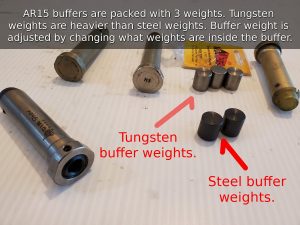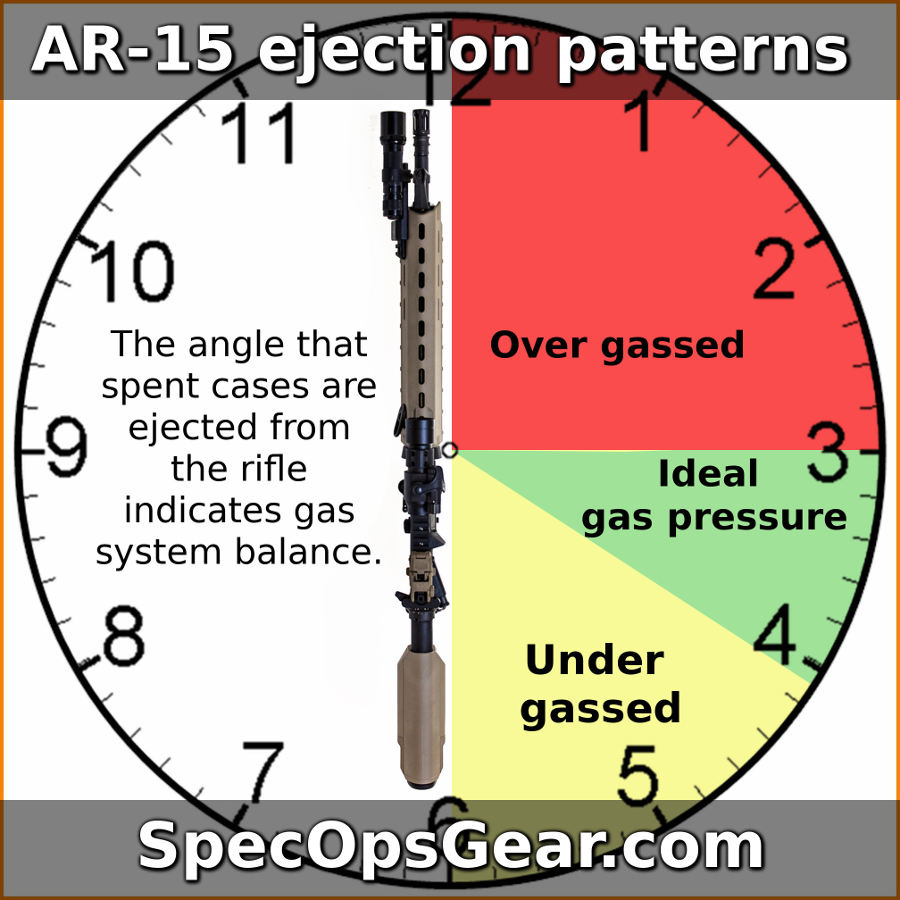AR15 Buffer Weights: Tungsten vs Steel

Standard-weight carbine buffers have 3 steel weights inside them. This mass helps counteract the rearward motion of the bolt carrier group as the firearm cycles. However, there are situations where some or all of those steel weights are swapped out in favor of heavier tungsten weights. Switching to a heavier buffer is the easiest way to solve an “overgassed AR15”. These heavier buffers are named H1, H2 and H3 to denote how many tungsten weights they have.
AR15 Ejection Pattern

The pattern in which spent cartridges eject from the firearm can tell you a lot about what’s going on inside the gun. The velocity at which the bolt carrier group (BCG) cycles back to unload the spent cartridge and load a fresh cartridge influences the angle that the spent case leaves the ejection port.
If you imagine that you’re standing on a clock face aiming your rifle downrange. Directly in front of you at the target is 12 o’clock, straight behind you is 6 o’clock, and directly to your right hand side is 3 o’clock. When you fire the gun, the spent cases should fly out at an angle between 3-4 o’clock. If the cases are in the 1-2:59 range, your gun is overgassed. Getting a heavier buffer is the easiest way to fix an overgassed AR15. If the cases land past 4 or the gun won’t lock open on empty or cycle then it under gassed and you need a lighter buffer.
The velocity of the BCG matters because if its moving too slow, it won’t have enough inertia to properly cycle and lock open when the magazine is empty. But, too much BCG velocity will also cause problems such as premature parts wear, excessive recoil and damage to the firearm and malfunctions. As such, you need just the right BCG velocity to make sure the gun reliably cycles, but not so much that it’s violently slamming back. Most military firearms tend to be a bit overgassed so that they will be sure to function in dirty combat environments where frequent cleaning and maintenance may not be possible.
Even still, an overgassed gun where the BCG cycles too fast is no fun and will wear out faster. Get your ejection pattern just right and you’ll get more enjoyment out of shooting. For this reason, I usually prefer AR15 buffer weights in the H2-H3 range and I also find them more comfortable to shoot quickly and accurately.
Rifle Vs Carbine Sized Buffer
Most modern AR-15 rifles have a carbine sized buffer in them. Adjustable/telescoping stocks and buffer tubes accept the carbine buffer in them. The less-common A2 rifle buffers are found in rifles that have the longer non-adjustable A2 stock pictured in this section. While its somewhat confusing, the term “carbine buffer” applies has two different meanings. Carbine buffer can mean a carbine-sized buffer with a standard carbine weight of 3oz, but there are also carbine-sized buffers available in heavier weights.
- Carbine Buffer
- Weight: 3 ounces (85.0 grams). This is the standard weight buffer in the standard carbine size housing. This carbine-sized buffer is packed with 3 steel weights inside of it. This is the most common size/weight buffer. You can easily spot one because it won’t have a stamped mark on its face.
- H1 Buffer
- Weight: 3.8 ounces (107.7 grams). Often called an “H” or “H1” buffer, this one will have a stamped letter H on its face. The H buffer is still in a carbine size, it’s just a bit heavier because it has 1 tungsten weight and 2 steel weights. An H1 is a good choice if your rifle is “just a little” over gassed.
- H2 Buffer
- Weight: 4.6–4.7 ounces (130.4-133.2 grams). This buffer will be stamped “H2” on its face. Aside from the H2 mark, it looks identical to the normal carbine buffer, except heavier. The H2 has 2 tungsten weights and 1 steel weight inside it. This buffer weight is perfect to moderately overgassed firearms or in cases where you want to reduce felt recoil.
- H3 Buffer
- Weight: 5.0–5.4 ounces (141.7-153.1 grams). Predictably, this buffer is stamped “H3” and looks the same as a carbine weight buffer except it’s significantly heavier. It has 3 tungsten weights and no steel weights inside of it. The H3 is one of my favorite buffers because it does such a great job of soaking up felt recoil and it makes it simpler to mount a suppressor. This buffer is recommended for significantly over-gassed firearms.
- Rifle-Length A2 Buffer
- Weight: 5.0 ounces (141.7 grams). The rifle-length A2 buffer is the odd duck here because its housing is significantly different from the more modern carbine-size. This housing is only found in fixed stock AR15s like the A2 buttstock. For me personally, the rifle-length A2 buffer is the most comfortable for me to shoot because it reduces recoil for faster follow-up shots. The only downside is that it only fits in the long, non-adjustable stocks.
- Pistol Caliber Carbine Buffer
- Weight: 5.0-8.5 ounces (141.7-241.0 grams). The pistol-caliber buffer is visually the same as the carbine except about twice as heavy. Ironically, pistol caliber AR15s (9mm luger, 45acp etc) use a heavier buffer weight than their rifle-caliber counterparts. This is due to pistol caliber carbines using a “straight blow-back” design instead of being gas-operated. While this buffer is intended for pistol-calibers, I have used it on suppressed rifle-caliber SBRs that were severely overgassed. I like the Odin-Works adjustable PCC buffer because you can change the weights much faster than on a normal buffer.

